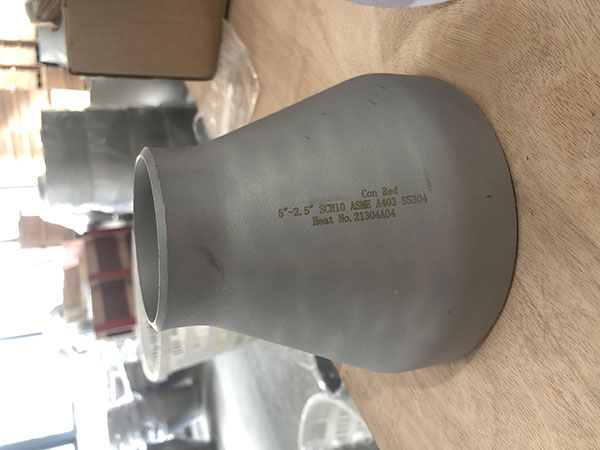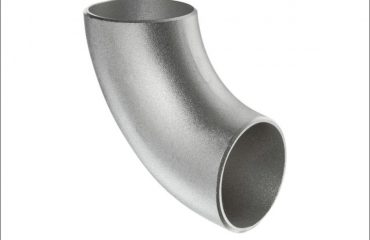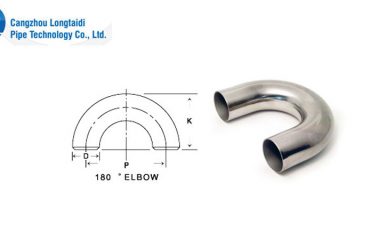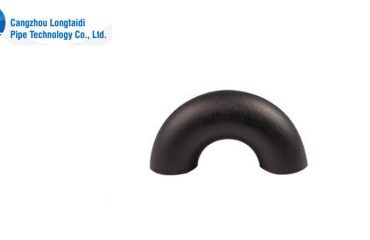
Redutor de aço inoxidável: Classes ASTM A403 WP
Introdução
Redutores de aço inoxidável são componentes vitais em sistemas de tubulação, projetado para conectar tubos de diferentes diâmetros, mantendo um fluxo suave de fluidos ou gases. Eles vêm em dois tipos principais: Redutores concêntricos, que têm uma linha central comum, e redutores excêntricos, que têm uma linha central deslocada. Este documento fornece uma introdução detalhada e uma análise aprofundada de redutores de aço inoxidável, especificamente aqueles compatíveis com as notas ASTM A403 WP, incluindo a 304, 304H, 309, 310, 316, 316L, 317L, 321, 347, e 904L.
Visão geral do ASTM A403 WP
ASTM A403 WP304 e WP304H
- WP304: O padrão 18/8 Aço inoxidável (18% cromo, 8% Níquel) conhecido por sua excelente resistência à corrosão e formabilidade.
- WP304H: Uma versão de alto carbono do WP304, fornecendo melhor força de alta temperatura.
ASTM A403 WP309
- Um cromo alto, Aço inoxidável de alto níquel, oferecendo resistência e força de oxidação superiores a temperaturas elevadas.
ASTM A403 WP310
- Conhecido por sua alta temperatura e resistência à corrosão, WP310 é ideal para aplicativos de serviço de alta temperatura.
ASTM A403 WP316 e WP316L
- WP316: Aprimorado com molibdênio para melhor resistência à corrosão, especialmente contra cloretos e outros solventes industriais.
- WP316L: Uma versão de baixo carbono do WP316, proporcionando excelente soldabilidade e minimizando o risco de precipitação de carboneto durante a soldagem.
ASTM A403 WP317L
- Semelhante ao WP316, mas com maior teor de molibdênio, oferecendo resistência superior à corrosão por pites e frestas.
ASTM A403 WP321
- Aço inoxidável austenítico estabilizado com titânio proporcionando excelente resistência à corrosão intergranular após exposição a temperaturas na faixa de precipitação de carboneto de cromo.
ASTM A403 WP347
- Aço inoxidável estabilizado com columbium com excelente resistência à corrosão intergranular, adequado para aplicações de alta temperatura.
ASTM A403 WP904L
- Aço inoxidável austenítico de alta liga com excelente resistência à corrosão, particularmente contra ácido sulfúrico, e propriedades mecânicas melhoradas.
Introdução detalhada
Composição e Propriedades
| Grau | Cr (%) | Ni (%) | Mo (%) | Outros elementos | Propriedades principais |
|---|---|---|---|---|---|
| WP304 | 18-20 | 8-10.5 | – | – | Resistência à corrosão, conformabilidade |
| WP304H | 18-20 | 8-10.5 | – | Dó alto | Resistência a altas temperaturas |
| WP309 | 22-24 | 12-15 | – | – | resistência à oxidação, força elevada |
| WP310 | 24-26 | 19-22 | – | – | Resiliência a altas temperaturas |
| WP316 | 16-18 | 10-14 | 2-3 | – | Resistência ao cloreto, durabilidade |
| WP316L | 16-18 | 10-14 | 2-3 | Dó baixo | soldabilidade, Resistência à corrosão |
| WP317L | 18-20 | 11-15 | 3-4 | Dó baixo | Resistência à corrosão por picadas e fendas |
| WP321 | 17-19 | 9-12 | – | Ti | Resistência à corrosão intergranular |
| WP347 | 17-19 | 9-12 | – | NB | Resistência à corrosão intergranular |
| WP904L | 19-23 | 23-28 | 4-5 | Cu, MN, Si | Resistência ao ácido sulfúrico, Dureza |
Propriedades mecânicas
| Grau | Resistência à tração (MPa) | Força de rendimento (MPa) | Alongamento (%) | Dureza (HB) |
|---|---|---|---|---|
| WP304 | 515 | 205 | 40 | 201 |
| WP304H | 515 | 205 | 40 | 201 |
| WP309 | 620 | 310 | 30 | 220 |
| WP310 | 620 | 310 | 30 | 220 |
| WP316 | 515 | 205 | 40 | 217 |
| WP316L | 485 | 170 | 40 | 217 |
| WP317L | 515 | 205 | 40 | 217 |
| WP321 | 515 | 205 | 40 | 217 |
| WP347 | 515 | 205 | 40 | 201 |
| WP904L | 490 | 220 | 35 | 192 |
Análise aprofundada
Resistência à corrosão
- WP304 e WP304H: Excelente resistência a uma ampla variedade de ambientes atmosféricos e muitos meios corrosivos.
- WP309 e WP310: Resistência superior à oxidação, adequado para ambientes de alta temperatura.
- WP316 e WP316L: Maior resistência a cloretos e solventes industriais, tornando-os ideais para ambientes marinhos e químicos.
- WP317L: Oferece resistência ainda melhor à corrosão por pites e frestas do que o WP316.
- WP321 e WP347: Ambas as classes resistem à corrosão intergranular, com WP321 estabilizado por titânio e WP347 por columbium.
- WP904L: Fornece resistência excepcional ao ácido sulfúrico e outros ambientes altamente corrosivos.
Desempenho em alta temperatura
- WP304H, WP309, WP310: Essas classes são projetadas especificamente para aplicações de alta temperatura, com WP304H oferecendo melhor resistência a altas temperaturas devido ao maior teor de carbono.
- WP321 e WP347: Ambas as classes apresentam bom desempenho em temperaturas elevadas, com elementos de estabilização ajudando a evitar a precipitação de carboneto.
Soldabilidade e Fabricação
- Série WP304 e WP316: Excelente soldabilidade e conformabilidade, adequado para uma ampla gama de aplicações.
- WP316L e WP317L: Versões com baixo teor de carbono oferecem soldabilidade superior, minimizando o risco de precipitação de carboneto.
- WP321 e WP347: Classes estabilizadas evitam a corrosão intergranular após a soldagem, tornando-os adequados para altas temperaturas, aplicações soldadas.
- WP904L: Embora seja mais difícil de soldar devido ao seu alto teor de liga, pode ser soldado com sucesso usando técnicas apropriadas.
Aplicações
- WP304 e WP304H: Comumente usado no processamento de alimentos, químico, e indústrias petroquímicas.
- WP309 e WP310: Ideal para peças de forno, Trocadores De Calor, e outras aplicações de alta temperatura.
- WP316 e WP316L: Amplamente utilizado em ambientes marinhos, Processamento químico, e equipamentos farmacêuticos.
- WP317L: Adequado para indústrias de processamento químico e petroquímica onde é necessária maior resistência à corrosão.
- WP321 e WP347: Usado em processamento químico e petroquímico de alta temperatura, geração de energia, e aplicações aeroespaciais.
- WP904L: Encontrado em processamento químico, particularmente onde o ácido sulfúrico está presente, bem como em dispositivos de resfriamento de água do mar e componentes de refinarias de petróleo.
processos de fabricação
Formando e Modelando
-
Conformação a Quente: Envolve aquecer o material a uma alta temperatura e depois moldá-lo usando prensas ou rolos. Este processo melhora a ductilidade do material e reduz o risco de fissuras.
-
Conformação a Frio: Realizado à temperatura ambiente, proporcionando melhor acabamento superficial e precisão dimensional. no entanto, requer mais força e pode induzir o endurecimento por trabalho.
De soldagem
-
TIG (Gás inerte de tungstênio) De soldagem: Fornece alta-qualidade soldas com excelente controle sobre a entrada de calor, adequado para componentes de paredes finas.
-
MEU (Gás Inerte Metálico) De soldagem: Mais rápido que a soldagem TIG, adequado para materiais mais espessos e ambientes de produção.
tratamento térmico
- Recozimento de Solução: Envolve aquecer o material a uma alta temperatura e depois resfriá-lo rapidamente para dissolver quaisquer carbonetos precipitados, restaurando sua resistência à corrosão.
Tratamento de superfície
- Decapagem e Passivação: Remove contaminantes da superfície e melhora a camada protetora natural de óxido do aço inoxidável, melhorando sua resistência à corrosão.
CONTROLE DE QUALIDADE
-
Teste não destrutivo (END): Técnicas como radiográficas, ultrassônico, e testes de penetrante de corante garantem a integridade e qualidade das soldas e materiais.
-
Inspeção dimensional: Garante que os redutores atendam às especificações e tolerâncias exigidas.
Tendências de mercado
Motivadores de demanda
- Desenvolvimento de infraestrutura: O aumento dos investimentos em projetos de infraestrutura impulsiona globalmente a demanda por sistemas de tubulação confiáveis.
- Indústria de petróleo e gás: As atividades contínuas de exploração e produção exigem materiais de alto desempenho que possam resistir a ambientes agressivos.
- Processamento químico: As crescentes indústrias de processamento químico exigem materiais com excelente resistência à corrosão e desempenho em altas temperaturas.
Análise Regional
- América do Norte: Demanda significativa devido à infraestrutura avançada, regulamentos rigorosos, e uma indústria robusta de petróleo e gás.
- Europa: O foco no desenvolvimento sustentável e regulamentações ambientais rigorosas impulsionam o mercado.
- Ásia-Pacífico: A rápida industrialização e urbanização contribuem para a crescente demanda por redutores de aço inoxidável.
Desafios
- Custos de matérias-primas: Flutuações nos preços de matérias-primas como o níquel, cromo, e o molibdênio podem impactar os custos de produção.
- Avanços tecnológicos: A inovação contínua é necessária para atender aos padrões da indústria em evolução e melhorar o desempenho dos materiais.
Conclusão
Redutores de aço inoxidável em conformidade com classes ASTM A403 WP, incluindo a 304, 304H, 309, 310, 316, 316L, 317L, 321, 347, e 904L, oferecem uma ampla gama de propriedades adequadas para diversas aplicações. Sua excelente resistência à corrosão, Desempenho em alta temperatura, e soldabilidade os tornam indispensáveis em indústrias como processamento químico, óleo e gás, e desenvolvimento de infraestrutura. Avanços contínuos na ciência dos materiais e nos processos de fabricação garantem que esses componentes atendam às demandas em constante evolução das aplicações de engenharia modernas.
Referências
- ASTM A403/A403M: Especificação padrão para conexões de tubulação de aço inoxidável austenítico forjado.
- ASM Internacional: Manual de Aços Inoxidáveis.
- NACE Internacional: Noções básicas sobre corrosão: Uma introdução.
- Literatura Técnica: Propriedades de materiais e processos de fabricação para redutores de aço inoxidável.
- Relatórios de mercado: Tendências e previsões para a indústria do aço inoxidável.




Você deve ser logado postar um comentário.